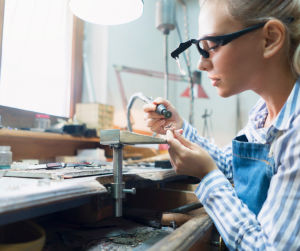When most people think of jewelry making, they picture creativity, craftsmanship, and sparkling designs. What they don’t always consider is the hidden danger: toxic fumes, dust, and airborne particles produced during the jewelry-making process.
Whether you’re soldering, polishing, or working with chemicals, proper ventilation is essential to protect both your health and the quality of your work. In this guide, we’ll explore why ventilation matters, what contaminants you need to control, and how to choose the best ventilation solutions for your jewelry lab.
Why Ventilation Matters in Jewelry Making Labs
Every time you heat metal, apply flux, or polish a piece, microscopic particles and toxic fumes are released into the air. Without proper ventilation, you could be exposing yourself to:
- Flux fumes, which may contain harmful substances like fluorides.
- Soldering gases, including volatile organic compounds (VOCs).
- Metal dust from grinding, sanding, and polishing.
- Chemical vapors from cleaning solutions and patinas.
Over time, exposure to these airborne contaminants can lead to respiratory problems, skin irritation, and even long-term health issues. That’s why creating a safe, well-ventilated workspace should be a top priority for any jewelry maker, from hobbyists to professional artisans.
Is Dilution Ventilation enough?
Many jewelry makers depend on dilution ventilation, which is where you open a window next to you, and another one elsewhere so that air passes you on its way out. However, this is not an effective method of ventilation. You don’t want the air and noxious materials to pass by your face before leaving.
You should have a fan with enough pull to drag the fumes away from you. A fume hood helps to focus the suction and helps to keep the fumes within the vicinity of the fan. The closer you are to a hood opening, the more effective it is.
Best Ventilation Solutions for Jewelry Studios
Choosing the right ventilation system depends on your space, processes, and budget. Here are the most effective options:
1. Fume Hoods (Ducted or Ductless)
- Ideal for: Soldering, brazing, and chemical work.
- How they work: Capture fumes at the source and either filter or vent them outside.
- Pro Tip: Look for HEPA and carbon filters to capture both particulates and chemical vapors.
2. Downdraft Tables
- Ideal for: Grinding, sanding, and polishing.
- How they work: Pull contaminants downward, away from the breathing zone, through a filtered work surface.
3. Local Exhaust Ventilation (LEV) Arms
- Ideal for: Spot extraction at soldering stations.
- How they work: Flexible arms with intake nozzles capture fumes right where they’re generated.
4. General Room Ventilation
- Ideal for: Larger studios.
- How they work: Combines exhaust fans, air exchange systems, and air purifiers to maintain overall air quality.

Where to Place a Fume Hood in a Jewelry Laboratory
Fume hoods should be positioned near the back of a workshop so that in the case of an accident, the exits aren’t blocked. There should also be enough space in front of it so that the personnel working in the studio don’t interfere with the airflow by passing directly in front of it. When the fume hood is in use, minimize foot traffic near the face opening. Also, avoid making fast movements when taking items in and out of the hood, and don’t direct any other ventilation toward it, such as portable fans or HVAC ductwork. These conditions will disrupt the airflow and create unwanted air currents that may allow contaminants to leave the hood and cause unwanted exposures, reducing its effectiveness.
The hood can be vented through a window, a wall, or through the ceiling. The fume hood must be set up correctly so that the vented air is removed completely and not immediately sucked back into the building by an incorrectly placed makeup intake duct.
When air is removed from the workspace, it then has to be made up from somewhere else. Usually, a duct is placed a safe distance away from the ventilation exit point. It is important to ensure that your make-up air is not bringing in exhaust fumes, and is not downwind from a chimney that is putting out toxic fumes. Make sure that you don’t create negative pressure in a basement workshop by venting so much air out that it causes air to be sucked into the space through a water heater or furnace exhaust vent- this backflow can fill your workspace with poisonous carbon monoxide gas.
Venting the air outside can also cause heating and cooling problems in the workspace. The most effective way to ensure proper ventilation and manage utility costs is to reduce the amount of air that is handled and use it only when necessary. There are many ways to conserve the amount of energy a fume hood uses, such as turning off the occupancy switch and keeping the sash closed when the hood isn’t in use. For local ventilation, a low-volume and high-air-speed fume hood is very effective.
Ventilation is more than just a comfort feature—it’s a safety essential for any jewelry-making lab. Whether you’re a solo artist or running a larger studio, investing in the right ventilation equipment will help protect your health, the quality of your work, and your long-term ability to create beautiful jewelry.
Need Ventilation Solutions for Your Jewelry Lab?
National Laboratory Sales offers a wide selection of fume hoods and laboratory furniture. If you’re looking for a fume hood for your jewelry-making environments, browse our selection or contact Kyle at (815) 670-6400.

